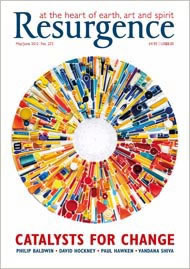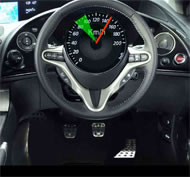Getting an idea to invent something is very much like capturing a photo. Ideas come to us all the time, as the brain never stops working. As a camera captures a running moment of nature, an invention is like a trapped idea. If we do not trap it, it goes away and will be difficult to capture again. We should have a recorder or a pen handy to record ideas when first conceived.
The idea of Green Pai Driving dawned to me while driving on 29th April 2008. Our modern cars are equipped with on-board computers to inform us about the instantaneous and historic fuel consumption, driving range with available fuel in the tank, graphics etc., but it does not inform us of something equally important – at what speed is the fuel consumption optimum? We have a fair knowledge of this, as we know that when we drive our car too fast, it consumes fuel at a higher rate. But, we are tempted to accelerate on high ways and end up using the fuel up much earlier than if we had had 'that' knowledge about optimum fuel consumption. I realised that if we gave this information to drivers then his/her driving would be more responsible and sustainable with the following results:
1. Savings on fuel costs by reducing significantly the fuel consumption of vehicles
2. Helping the atmosphere due to less emission of toxic gases.
3. Conserving the important, non-renewable, natural resource petroleum, by significantly reducing fuel consumption. Petroleum has several other applications which we use daily, and we do not, as yet, have any alternative to it.
Under standard and equal conditions, a car driven at 80 kms/hour may use its 55 litres of fuel to travel 660 kms, but the same car driven at 130 kms may travel only up to 550 kms. Looking at this fact from an environmental point of view, the driver has recklessly burned/wasted fuel worth of 110 kms. Waste is one of the failings of the modern world, and is a sin against Nature. This has not only impacted on the environment (sustainability factor), but the driver has also spent more money for the journey (economy factor), and wasted precious, natural (non-renewable) resource – petroleum (ecological factor). There is enough oil in the world for our need, but not enough for high speed. Generally people are worried about traffic fines for high speed driving with no awareness or consciousness of the wider impact of their actions. This reality needs to be challenged.
The GPD invention is an automobile mechanism whereby the Speedo-meter has an additional display in the shape of a green pie. This indicator allows the driver to see when the automobile is being driven within its capacity for optimum fuel usage. Speed that goes above the GPD is a clear indication that the automobile is consuming fuel much more than it should be.
Before inventing the GPD, I pondering for months about how we could lessen the pollution caused by automobile emissions. These emissions are the biggest contributor to the Green House Gas effect. If we can lessen these emissions this will be a big help in reducing the global warming and dealing with the climate crisis.
Vehicles are emitting toxic gases in the environment all the time, while we drive. In today’s world, these toxic gases are invisible, colourless and without much smell. Only if someone gets very close to the exhaust will they notice its smell. Our technology has done a 'good job' in making these emissions invisible – with hardly any colour or smell. Gone are the days when we used to see cloudy, black or white fumes coming out of auto exhausts with their associated horrible smells.
This 'good job' done by the automobile industry has taken our consciousness away from the fact that we are damaging the beautiful environment through high speed driving. Samuel Johnson once said, “The road to the hell is paved with good intentions”. By making the automobile gas emissions invisible, the public in general has no awareness of, and is not concerned by its impact on Nature and the environment.
There is no need to make the emissions smoky and smelly to bring these concerns back into public consciousness – we could bring it by adding the GPD mechanism to our automobiles. A person driving a vehicle within the GPD speed limit is assured that he/she is not letting the vehicle emit more toxic gases than necessary in making a particular journey. This awareness about toxic gases emitted for each journey has many direct and indirect advantages.
The technology around us has brought us more comfort, safety and speed in our automobiles: headlights turn on automatically when the car enters a tunnel, the wipers start automatically when rain start, the interior temperature gets adjusted automatically with the exterior temperature. So many other gadgets, like auto parking, auto cruise and sensors on bumpers leave customers in awe when selecting their new cars.
With all this automation, the driver has less and less to do. We see this as a sign of prosperity and technological innovation. But wait for a moment – to think. Has it reduced the pollution or the problems of global warming? Has taken our attention away from it? If we decide to give attention to these problems, would we go for more automation or give the decisive control back to the human being sitting behind the steering wheel?
It is the human who needs to intervene to reduce pollution, as it the human who can understand the gravity of the problems and has passion to work towards to solving it. Instead, if we disassociate ourselves from the problem and leave the machines to solve it, then we would be heading towards even bigger ecological disasters.
With the invention of GPD, I aim to bring decision-making and control back to the human who is driving the vehicle. GPD collects the data from some 8 points on the vehicle and informs the driver at what speed the fuel consumption is the lowest. It is then up to the driver to put the required pressure on the pedal! Conservative estimate indicates that it would bring a saving of 1 million litres of fuel per day, for a country the size of Portugal.
In spite of all this, GPD is not available in its original form to the general public. The tough automobile industry ultimately decides which new technologies are added to cars and which are not. A renowned German automobile manufacturer informed me of this, categorically and in writing – after a long sequence of communication exchanges. I can understand that. How could they promote a new model with a powerful engine (to drive up to 250 Kms/h) with a GPD display which ranges between 80 and 100 kms? That was back in 2009, but the rules that seemed set around the world years ago, are changing fast.
With the financial crisis and the melt down of corporations and countries, BP’s oil spill, the Libyan war and the ever-increasing austerity for everyone, yesterday’s rules are no longer valid for today. The rules of tomorrow are bound to be different than those of today, as they need to adapt to tomorrow’s needs. In the beginning of 2011, when the civil riots started in Libya and oil prices started to soar, the Spanish government reduced the maximum speed limit on highways from 120 kms/h to 110 kms/h. This decision was founded in the same principles as the GPD and the initiative reduced fuel consumption in the country considerably. This real example shows that it can take time for a good idea to be accepted in society, but it's time will surely come – and one day, GPD will be implemented in practice.
For more of GPD, visit: www.green-pai-driving.info







